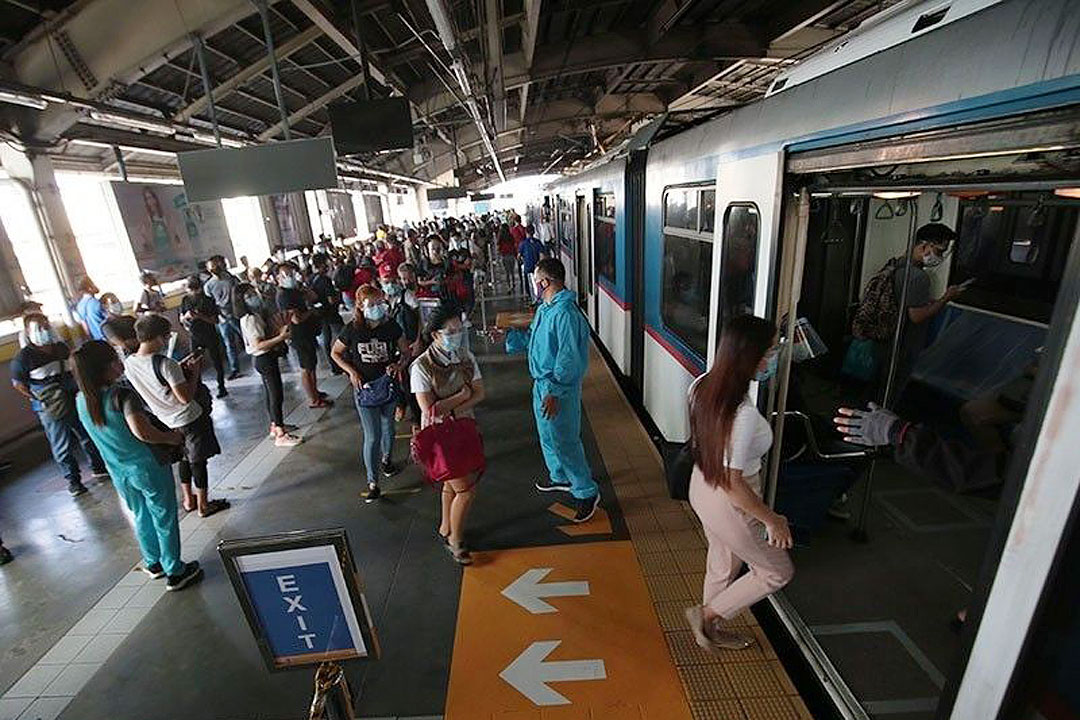By Arjay L. Balinbin, Senior Reporter
Ridership on the four rail networks rose more than 172% year on year to 47.57 million between April and September, well below equivalent levels in 2019, the Transportation department said, with analysts estimating that passenger volumes could take at least three years to return to their pre-pandemic levels.
Passenger volumes on Light Rail Transit Lines 1 and 2 (LRT-1 and LRT-2), Metro Rail Transit Line 3 (MRT-3), and the Philippine National Railways (PNR) increased 172.45% during the period, according to the Department of Transportation.
The period was selected to exclude January-to-March data for both 2020 and 2021, which were heavily distorted by lockdowns.
Train ridership for the same period in 2019, or before the pandemic, totaled 161.78 million.
The government imposed a 30% cap on rail passenger capacity during the strictest phases of the community quarantine. It was raised to 70% starting Nov. 4.
“Studies have shown that only 0.2% of traceable outbreaks in Germany were linked to transport; only 1.2% of COVID-19 (coronavirus disease 2019) clusters are linked to transport (land, air, and sea); and that there is only a 0.01% chance of contracting COVID-19 in public transportation, with the probability decreasing to 0.005% risk of infection with face covering,” Transportation Undersecretary for Railways Timothy John R. Batan said in a recent statement.
Transportation expert Rene S. Santiago told BusinessWorld by phone Monday that lockdowns and capacity limits had “curtailed ridership.”
He also noted that the uptick in ridership this year “could reflect relaxation of restrictions.”
“(Ridership) will not get back to pre-pandemic levels for at least three years,” Mr. Santiago added.
Light Rail Manila Corp. (LRMC), the private operator of LRT-1, is hoping that 2022 will be a much better year than 2021.
“The gradual increase and return to pre-pandemic level of our ridership will have to depend on several factors, so it’s hard to give a forecast at this point,” LRMC Spokesperson Jacqueline S. Gorospe told BusinessWorld in a phone message.
“Aside from the resumption of more economic activities, some of the main factors include the government’s policy for ridership capacity, public confidence, opening of schools/universities, and return to physical work in companies,” she added.
LRMC reported a 20% year-on-year decline in nine-month revenue to P799 million due to capacity reductions and lower demand.
LRT-1’s average daily ridership decreased 48% year on year to 116,021 due to the 30% cap.
LRMC is the consortium composed of Ayala Corp., Metro Pacific Light Rail Corp. (a unit of Metro Pacific Investments Corp.) and Macquarie Infrastructure Holdings (Philippines) Pte. Ltd.
Metro Pacific Investments Corp. is one of three Philippine subsidiaries of Hong Kong’s First Pacific Co. Ltd., the others being PLDT, Inc. and Philex Mining Corp. Hastings Holdings, Inc., a unit of PLDT Beneficial Trust Fund subsidiary MediaQuest Holdings, Inc., maintains an interest in BusinessWorld through the Philippine Star Group.
